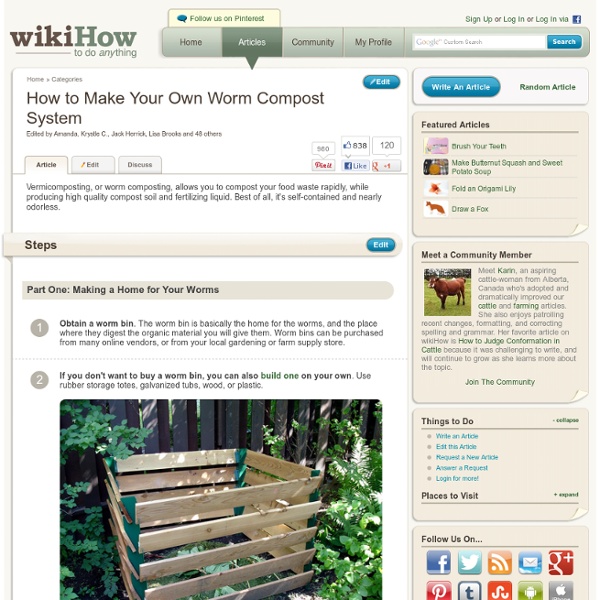How to Build a Tumbling Composter
Edit Article Edited by Tom Stricker, James Quirk, Tom Viren, Sondra C and 28 others One of the keys to composting is aeration. The bacteria need oxygen to carry out the aerobic respiration that creates rich compost. Ad Steps 1Buy a plastic drum, between 20 and 55 gallons (75-200 liters). 11Check the contents occasionally, and when they are broken down by the bacteria in the drum, remove them to use for soil amending, mulch, and other purposes around your lawn and garden. Tips Composting (decomposing) occurs more quickly in warm weather.You could also build the tumbler on a diagonal axis (enough to create a slope) and put a plug in the bottom of the drum, which would allow you to add water that will help the decomposition and create a liquid fertilizer when drained from the drum.If your barrel is a light color you might consider painting it a dark green, brown, or black. Warnings
Build an Ant Farm
By Rebecca ClarkIllustrated by Sabine Deviche Materials Two clear plastic CD cases, standard width Sieve for soil Dry soil, ideally from place where ants were collected (approximately 3 cups before sifting) Container for sifted soil (approximately ½ cup after sifting) Utility knife or other sharp knife that can cut plastic Clear packing tape Spoon Eyedropper (for watering soil) Straightedge for scoring and cutting plastic Marker to note exit/entry point location Two pieces of dark construction paper, or aluminum foil to cover sides of farm This project requires adult supervision for cutting plastic. Video Tutorial Step by Step Instructions 1. 2. Mark the corresponding location on the underside of the upper CD case, where you will carve a small, circular hole using a utility knife or other sharp blade.The plastic may crack if you carve too quickly, so work gradually and avoid applying too much pressure. 3. 4. C. D. 5. 6. 7. E.
How to Build a Compost Bin
Steps Method 1 of 3: Building a General-Purpose Compost Bin a Compost Bin Step 1.360p.mp4 00:00 00:06 00:06 spaceplay / pauseescstopffullscreenshift + ←→slower / faster (latest Chrome and Safari)←→seek . seek to previous 12…6 seek to 10%, 20%, …60% 1Gather your materials. Method 2 of 3: Building a Yard-Waste-Only Compost Bin a Compost Bin Step 10.360p.mp41Cut out a large rectangle of chicken wire.
Project WILD in Ohio
Project WILD Training Workshops >> Project WILD involves young people and wildlife, a proven formula for generating interest and participation. Project WILD is a supplementary education program emphasizing awareness, appreciation, and understanding of wildlife and natural resources. Attractive and easy to use, Project WILD is an ideal way to supplement your curriculum and fire the imagination of your students. Project WILD teaches young people how to think about wildlife, not what to think. Students in kindergarten through twelfth grade learn basic concepts about wild animals, their needs and importance, and their relationships to people and the environment. Project WILD was developed through a joint effort of the Western Association of Fish and Wildlife Agencies and the Council for Environmental Education. The pre-K Growing Up WILD guide from Project WILD is also available through workshops. Hello High School Teachers!! Hey Early Childhood Educators!!!
Compost Bins: Compost bin reviews, info on compost bins, tumbler
While some people choose to go binless opting for a simple heap on the ground, most of us prefer to use some kind of an enclosure for making our compost. There are a number of types of containers used to make compost but which type is best? Well, the answer depends largely on how much space you have in your yard or garden and how much material you will be composting. In general, the commercially made plastic compost bins are better for beginner composters, while the larger homemade bins are more suited to avid gardeners and those who have a larger volume of materials. Plastic Bin: Due to their generally smaller size, commercially made plastic compost bins tend to be better for those who are not avid gardeners but want to compost some leaves and kitchen scraps. Advantages of Plastic Compost Bins: Locking lid keeps out vermin and local wildlife Inexpensive and readily available Disadvantages of Plastic Compost Bins: Homemade Compost Bins Here are some examples: Compost Tumbler:
Double-Decker Drum Composter
I decided against documenting every step with building the frame, mainly because it's a simple enough design. The frame consists of 3 pressure treated 4x4's and 1 pressure treated 1x4, all eight feet long. One 4x4 was cut exactly in half and the 1x4 was cut into quarters - they were to become the 2 beams and 4 stakes. I drilled pilot holes through the posts and into the beam and held them together with galvanized lag bolts. I used a 2 inch hole saw to cut holes into sides of the posts so they can hold the poles later on. Then, I used some exterior screws to fasten the stakes to the bottom of the posts. At the bottom of the posts and stakes, I drilled some screws partially into the wood to hold them into the cement better.



